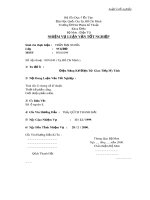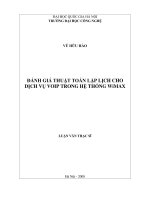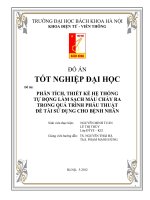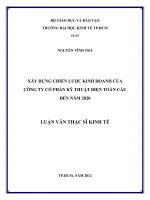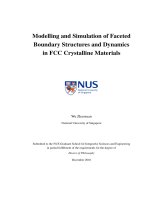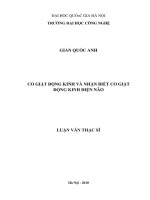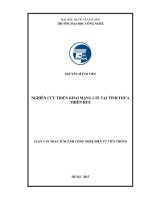(Luận văn thạc sĩ) modelling and simulation of the capacitive acceleration sensor luận văn ths kỹ thuật điện tử viễn thông 2 07 00
Bạn đang xem bản rút gọn của tài liệu. Xem và tải ngay bản đầy đủ của tài liệu tại đây (31.88 MB, 87 trang )
VIETNAM N A TIO N A L U N IV ERSITY , HANOI
COLLEGE OF TECH NO LO G Y
np
Ằ_
_ 'TI A __
T ran Đ ứ c Tan
M O D E L IN G A N D S IM U L A T IO N
O F TH E C A P A C IT IV E A C C E L E R A T IO N S E N S O R
Field: Electronics and Telecommunication
Code: 2.07.00
MASTER THESIS
Scientific Advisor:
P ro f. D r N g u y e n P h u T h u y
Hanoi, 2004
Đ Ạ I H Ọ C Q U Ố C G IA H À N Ộ I
TRƯỜNG ĐẠ
• • I H Ọ•C C Ơ N G N G H Ệ •
TP
Ậ_
T\
w
_
np £ _
_
Tran Đ ứ c lâ n
M Ơ HÌNH HĨA VÀ MƠ PHỎNG
SENSO R GIA TỐC KIỂU TỤ
C h u y ê n n g à n h : K ỹ th u ậ t vô tu y ế n đ iện tử v à th ô n g tin liên lạc
M ã số
: 2 .0 7 .0 0
L U Ậ N V Ă N T H Ạ C SỸ
C án bộ h ư ớ n g dẫn:
G S .T S K H N g u y ễ n P h ú T hu ỳ
H à N ộ i, 2 0 0 4
TABLE OF CONTENTS
ASSURAïvCE
ACKNOWLEDGMENTS
LI ST OF TABLES
LI ST OF FIGURES
FOREWORD
CHAPTER 1. INTRODUCTION
1.1 Overview of MEMS
1
1
->
1.2 Silicon Micro Accelerometers
1.2.1 Electromechanical Accelerometers
1.2.2 Piezoelectric Accelerometers
1.2.3 Piezoresistive Accelerometers
1.2.4 Electrostatic Accelerometers
1.2.5 Resonant Accelerometer
1.3 MEMS Modeling and Simulation
CHAPTER 2. ACCELEROMETER: FROM THEORY TO DESIGN
2.1 Operational Principles
2.1.1 Open-Loop Design
2.1.2 Force-Balance Design
20
2.1.3 Comparisons
2.2 Capacitive Accelerometer
2.2.1 Position Measurement with Capacitance
2.2.2 Noise Analysis
CHAFTER 3. MODELING AND SIMULATION OF THE ACCELEROMETER
3.1 Overview of SUGAR
3.2 Nodal Analysis Approach
3.3 Simulation Program based on SUGAR
24
26
27
32
35
35
36
45
4
5
6
7
8
9
14
14
15
3.4 Simulation Result
3.4.1 Single Capacitive Accelerometer
3.4.2 Differential Capacitive Accelerometer with a Single Beam
3.4.3 Differential Capacitive Accelerometer with Two Symmetric Beams
3.4.4 Two Parallel Beams Accelerometer
47
47
52
54
56
3.4.5 Four Symmetric Beam Accelerometers
3.5 Experimental Calibration Set-up and Experimental Results
57
55
3.6 Comparison o f the simulation and experimental results
63
CHAPTER 4. CONCLUSIONS
4.1 Concluding Remarks
4.2 Future Work
4.3 List o f Publications
REFERENCE
APPENDIX
67
67
68
70
71
74
Abbreviation
ASIC
Application-Specific Integrated Circuit
CAD
Computer-Aided Design
CTS
Clear To Send
Ctf
Capacitance to Mtage Converter
FEA
Finite Element Analysis
FHSS
Freqency H oping Spread Spectrum
ICs
Integrated Circuits
ITIMS
International Training Institute for Materials Science
LIGA
Lithography Galvanoforming Moulding Processes
MEMS
Microelectromechanical Systems
MOEMS
M icroO ptoE lectroM echanical Systems
ODEs
Ordinary Differential Eqations
PDM
Pulse D ensity M odulation
P-P
Peak to Peak
PWM
Pulse W idth M odulation
RTS
R eqest To Send
List of Tables
T able 1.1. A vailable M EM S sim ulation tools, by level and view
13
T able 3.1 Physical param eters o f the sim ple capacitive accelerom eter
47
T able 3.2 G eom etry param eters o f the single capacitive accelerom eter
48
T able 3.3 R elation betw een b eam ’s thickness and resonant frequency
50
T able 3.4 R elation betw een b eam ’s length and resonant frequency
51
T able 3.5 R elation betw een b eam ’s thickness and resonant frequency
55
T able 3.6 R elation betw een b eam ’s thickness and resonant frequency
58
List of Figures
Figure 1.1 A compression type piezoelectric accelerometer arrangement
6
Figure 1.2: Piezoresistive acceleration sensor
7
Figure 1.3 Capacitive measurement of acceleration
8
Figure 1.4 Resonant accelerometer
9
Figure 1.5 Cantilever beam and beam - capacitor options
11
Figure 1.6 Nodal analysis and finite elements analysis
12
Figure 1.7 Ideal and actual cantilever beams (side view)
12
Figure 2.1 Open loop accelerometer
15
Figure 2.2 Frequency response and phase response with various damping
19
Figure 2.3 Transient responses with various damping
20
Figure 2.4 Force - balance accelerometer
21
Figure 2.5 Variety o f capacitor structures used for position sensing
27
Figure 2.6 Variety o f differential capacitor structures
27
Figure 2.7 Typical circuit use o f a differential capacitor
28
Figure 2.8 Transimpedance amplifier capture the capacitor current
29
Figure 2.9 Feedback capacitor is added to circuit of Fig 2.8
30
Figure 2.10 Measurement the output voltage of a differential capacitor
31
Figure 3.1. A simple MEMS structure
37
Figure 3.2 A bent beam showing nodal forces, moments, and coordinates
39
Figure 3.3 the level-2 model o f an electrostatic actuator
44
Figure 3.4 Flow chart o f the simulation program
46
Figure 3.5 Single capacitive accelerometer
48
Figure 3.6 Steady responses of the single capacitive accelerometers with different beam
thicknesses
49
Figure 3.7 Relation between beam’s thickness and resonant frequency
50
Figure 3.8 Relation between beam’s width and resonant frequency
51
Figure 3.9 Differential capacitive accelerometer with a single beam
53
Figure 3.10 Relation between the voltage and the proof mass’s displacement of the
differential capacitive accelerometer with single beam
53
Figure 3.11 A differential capacitive accelerometer with two symmetric beams
54
Figure 3.12 Relation between the voltage and proof mass’sdisplacement of the
differential capacitive accelerometer with two symmetric beams
Figure 3.13 Two Parallel Beams Accelerometer
55
56
Figure 3.14 Relation between voltage and acceleration of two parallel beams
accelerometers
57
Figure 3.15 Four symmetric beam accelerometer
57
Figure 3.16 Relation between voltage and acceleration of the four symmetric beams
accelerometer with different beam’s thickness
Figure 3.17 The response frequency o f system under dam ping
58
59
Figure 3.18 Differential capacitive acceleration sensors with: double beamsand (b)
four symmetrical beams
60
Figure 3.19 Calibration set-up consisting of the rotating disk,
circuits and the capacitive acceleration sensor under test
Figure 3.20 The CVC circuit and interface
of the calibration set-up
the CVC, wireless
61
61
Figure 3.21 Relation between voltage and acceleration of the different sensors with the
configurations noted in the figures
62
Figure 3.22 Relation betw een the voltage and the acceleration: com parison
betw een sim ulation and experim ental results
65
Figure 4.1 A newly suggested structure with four symmetric beams
68
Figure 4.2 A comb structure proposed for future work
69
Foreword
MEMS technology has been developed since 1960 and MEMS products
have been commercialized and widely used around the world since 1980. In
Vietnam, however, this new field of technology has only been studied several
years ago. Following this trend, the College of Technology o f VNUH started
research on MEMS devices and their applications in 2003. This thesis is a
continuation o f this effort and is the first attempt to investigate and design
MEMS sensor by modeling and simulation.
My thesis includes four chapters. The first chapter introduces an overview of
MEMS and discusses some types of accelerometers. Capacitive accelerometer has
been chosen to be the object of my thesis because of its high sensitivity, good dc
response, noise performance, low drift, low temperature sensitivity, low-power
dissipation, and simple structure. Chapter 2 discusses operational principles of openloop and force-balance accelerometers. In addition, results of position measurement
and noise analysis of the capacitive accelerometer are given. Chapter 3 focuses on
modeling and simulation of different structures using SUGAR language in MATLAB
environment.
In particular, the simulation results are compared to experimental
results. Finally, the conclusions of this research and proposal for future study are
presented in chapter 4 of this thesis.
Chapter I
CHAPTER 1
INTRODUCTION
1.1
Overview of MEMS
M icroelectrom echanical systems (M EM S) are collection o f m icrosensors and
actuators that have the ability to sense its environm ent and react to changes in that
environm ent w ith the use o f a m icrocircuit control. They also include the
conventional
m icroelectronics
packaging,
integrating
antenna
structures
for
com m and signals into m icroelectrom echanical structures for desired sensing and
actuating functions. The system may also need m icropow er supply, microrelay, and
m icrosignal processing units. M icrocom ponents m ake the system faster, more
reliable, cheaper, and capable o f incorporating m ore com plex functions.
In the beginning o f 1990s, M EM S appeared w ith the aid o f the developm ent
o f integrated circuit fabrication processes, in w hich sensors, actuators, and control
functions
are
co-fabricated in silicon
[1]. Since then, rem arkable research
progresses have been achieved in M EM S under the strong prom otions from both
governm ent and industries. In addition to the com m ercialization o f some less
integrated M EM S devices, such as m icroaccelerom eters, inkjet printer head,
m icrom irrors for projection, etc., the concepts and feasibility o f m ore complex
M EM S devices have been proposed and dem onstrated for the applications in such
varied fields as m icrofluidics, aerospace, biom edical, chem ical analysis, wireless
com m unications, data storage, display, optics, etc. Som e branches o f M EM S.
appearing as m icrooptoelectrom echanical system s (M O E M S), m icro total analysis
system s, etc., have attracted a great research since their potential applications'
m arket.
At the end o f 1990s, m ost o f M EM S devices w ith various sensing or
actuating m echanism s w ere fabricated using silicon bulk m icrom achining, surface
Modeling and simulation o f the capacitive accelerometer
1
Chapter I
m icrom achining, and lithography, galvanoform ing, m oulding (L1GA) processes [2 1.
Three-dim ensional m icrofabrication processes incorporating m ore m aterials were
presented for M EM S recently because o f specific application requirem ents (e.g..
biom edical devices) and higher output pow er m icroactuators.
M icrom achining has becom e the fundamental technology for the fabrication
o f M EM S devices and, in particular, m iniaturized sensors and actuators. Silicon
m icrom achining is the m ost advanced o f the m icrom achining technologies, and it
allow s for the fabrication o f M EM S that have dim ensions in the subm illim eter
range. It refers to fashioning m icroscopic m echanical parts out o f silicon substrate
or on a silicon substrate, m aking the structures three dim ensional and bringing new
principles to the designers. Em ploying m aterials such as crystalline silicon,
polycrystalline silicon, silicon nitride, etc., a variety o f m echanical m icrostructures
including beam s, diaphragm s, grooves, orifices, springs, gears, suspensions, and a
great diversity o f other com plex m echanical structures have been conceived.
In som e applications, stresses and strains to which the structure is subjected
to may pose a problem for conventional cabling. In others, environm ental effects
may affect system perform ance. A dvances in ultra flat antenna technology coupled
w ith M EM S sensors and actuators seem to be an efficient solution. The integration
o f m icrom achining and m icroelectronics on one chip results in so-called sm art
sensors [3], In sm art sensors, small sensor signals are am plified, conditioned, and
transform ed into a standard output format. They may include m icrocontroller,
digital signal processor, application-specific integrated circuit (ASIC), self-test,
self-calibration, and bus interface circuits sim plifying their use and m aking them
m ore accurate and reliable.
Silicon m icrom achining has been a key factor for the vast progress o f M EM S
in the last decade. This refers to the fashioning o f m icroscopic m echanical parts out
o f silicon substrates and, more recently, other m aterials. It is used to fabricate such
features as clam ped beam s, m em branes, cantilevers, grooves, orifices, springs,
gears, suspensions, etc. These can be assem bled to create a variety o f sensors. Bulk
m icrom achining is the com m only used m ethod, but it is being replaced by surface
m icrom achining that offers the attractive possibility o f integrating the m achined
Modeling and simulation o f the capacitive accelerometer
2
Chapter I
device with m icroelectronics that can be patterned and assem bled on the same
wafer. Thus pow er supply circuitry and signal processing using ASICs can be
incorporated. It is the efficiency o f creating several such com plete packages using
existing technology that m akes this an attractive approach.
1.2
Silicon Micro Accelerometers
M icrom achined inertial sensors, consisting o f acceleration and angular rate
sensors are produced in large quantities m ainly for autom otive applications |4J,
where they are used to activate safety systems, including air bags, and to implement
vehicle stability system s and electronic suspensions. Besides these automotive
applications accelerom eters are used in many other applications w here low cost and
small size are im portant, e.g. in biom edical applications for activity m onitoring and
in consum er applications such as the active stabilization o f cam corder pictures.
M iniaturized acceleration sensors are also o f interest to the air and space industries
and for m any other applications.
Silicon acceleration sensors generally consist o f a p ro o f mass which is
suspended to a reference frame by a spring elem ent. A ccelerations cause a
displacem ent o f the p ro o f mass, which is proportional to the acceleration. This
displacem ent can be m easured in several ways, e.g. capacitively by m easuring a
change in capacitance betw een the proof m ass and an additional electrode or
pie 2oresistively by integrating strain gauges in the spring elem ent [3], To obtain
large sensitivity and low noise a large p ro o f mass is needed, which suggests the use
o f bulk m icrom achined techniques. For less dem anding applications surface
m icrom achined devices seem to be m ore attractive because o f the easy integration
with electronic circuits and the fact that bulk m icrom achining requires the use o f
wafer bonding step [5]. Recently, som e designs have been presented w hich combine
bulk and surface m icrom achining to realize a large p ro o f m ass in a single wafer
process.
The technology can be classified in a num ber o f w ays, such as mechanical or
electrical, active or passive, deflection or null-balance accelerom eters, etc.
Modeling and simulation o f the capacitive accelerometer
Chapter 1
This thesis review ed follow ing type o f the accelerom eters:
> Electrom echanical
> Piezoelectric
> Piezoresistive
> Capacitive and electrostatic force balance
> R esonant accelerom eter
D epending on the principles o f operations, these accelerom eters have their own
subclasses.
1.2.1
E lectro m ech a n ica l A ccelerom eters
E lectrom echanical accelerom eters [6], essentially servo or null-balance
types, rely on the principle o f feedback. In these instrum ents, an accelerationsensitive m ass is kept very close to a neutral position or zero displacem ent point by
sensing the displacem ent and feeding back the effect o f this displacem ent. A
proportional m agnetic force is generated to oppose the m otion o f the mass displaced
from the neutral position, thus restoring this position ju st as a m echanical spring in a
conventional accelerom eter w ould do. The advantages o f this approach are better
linearity and elim ination o f hysteresis effects, as com pared to the mechanical
springs. A lso, in som e cases, electrical dam ping can be provided, which is much
less
sensitive
to
tem perature
variations.
One
very
im portant
feature
of
electrom echanical accelerom eters is the capability o f testing the static and dynamic
perform ances o f the devices by introducing electrically excited test forces into the
system . This rem ote self-checking feature can be quite convenient in complex and
expensive tests w h ere accuracy is essential. These instrum ents are also useful in
acceleration control system s, since the reference value o f acceleration can be
introduced by m eans o f a proportional current from an external source. They are
used for general-purpose m otion m easurem ents and m onitoring low-frequency
vibrations. There are a n um ber o f different electrom echanical accelerom eters: coiland-m agnetic types, induction types, etc.
Modeling and simulation o f the capacitive accelerometer
4
Chapter 1
1.2.2 P iezoelectric A ccelerom eters
Piezoelectric
accelerom eters
are
widely
used
for
general-purpose
acceleration, shock, and vibration m easurem ents. They are basically m otion
transducers w ith large output signals and com paratively sm all sizes and they are sell
generators not requiring external pow er sources. They are available with very high
natural frequencies and are therefore suitable for high-frequency applications and
shock m easurem ents. These devices utilize a m ass in direct contact with the
piezoelectric com ponent or crystal as show n in Fig. 1.1. W hen a varying m otion is
applied to the accelerom eter, the crystal experiences a varying force excitation (F
m a), causing a proportional electric charge q to be developed across it. So,
q = d,jF = djina
( 1. 1 )
W here q is the charge developed and dy is the piezoelectric coefficient o f the
m aterial.
A s this equation show s, the output from the piezoelectric m aterial is dependent on
its m echanical properties, djj. Tw o com m only used piezoelectric crystals are leadzirconate titanate ceram ic (PZT) and crystalline quartz. They are both selfgenerating m aterials and produce a large electric charge for their size. The
piezoelectric strain constant o f PZT is about 150 tim es that o f quartz. As a result.
PZTs are m uch m ore sensitive and sm aller in size than quartz counterparts. These
accelerom eters are useful for high-frequency applications. These active devices
have no DC response. Since piezoelectric accelerom eters have com paratively low
m echanical im pedances, their effect on the m otion o f m ost structures is negligible.
a
PZT crystal
Output
MASS
PZT crystal
o --------------Figure 1.1 A compression type piezoelectric accelerometer arrangement.
Modeling and simulation o f the capacitive accelerometer
5
Chapter!
The low-frequency response is limited by the piezoelectric characteristic,
while the high frequency response is related to mechanical response. The damping
factor is very small and it is usually less than 0.01 or near zero. Accurate lowfrequency response requires large dam ping factor, which is usually achieved by use
o f high-im pedance voltage am plifiers. At very low frequencies therm al effects can
have severe influences on the operation characteristics. Piezoelectric accelerom eters
are available in a wide range o f specifications and are offered by a large num ber o f
m anufacturers.
1.2.3 P iezoresistive A ccelerom eters
Piezoresistive accelerom eters (see Fig. 1.2) are essentially sem iconductor
strain gauges with large gauge factors. High gauge factors are obtained since the
m aterial resistivity is dependent prim arily on the stress, not only on the dimensions.
The sensitivity o f a piezoresistive sensor comes from the elastic response o f its
structure and resistivity o f the m aterial. W ire and thick or thin film resistors have
low gauge factors, that is, the resistance change due to strain is small. Piezoresistive
accelerom eters are useful for acquiring vibration inform ation at low frequencies, for
exam ple, below 1 Hz. In fact, they are inherently true non-vibrational acceleration
sensors. They generally have w ider bandwidth, sm aller nonlinearities and zero
shifting, and better hysteresis characteristics com pared to piezoelectric counterparts.
They are suitable to m easure shocks well above 100,000g. Typical characteristics o f
piezoresistive accelerom eters may be listed: 100 m V /g as the sensitivity, 0 -7 5 0 Hz
as the frequency range, 2500 Hz in resonance frequency, 25g as the am plitude
range, 2000g as the shock rating, and 0-95°C as the tem perature range. The total
m ass is about 25 g. M ost contem porary piezoresistive sensors are manufactured
from a single piece o f silicon. This gives better stability and less thermal mismatch
betw een parts. In a typical m onolithic sensing elem ent a 1-mm silicon chip
incorporates the spring, m ass and four-arm bridge assem bly. The elem ents are
form ed by a pattern o f dopant in the originally flat silicon. Subsequent etching o f
channels frees the gauges and simultaneously defines the m asses as regions o f
silicon o f original thickness.
Modeling and simulation o f the capacitive accelerometer
6
Chapter 1
Figure 1.2: Piezoresistive acceleration sensor.
1.2.4 E lectrostatic A ccelerom eters
Electrostatic accelerom eters are based on C oulom b’s law between two
charged electrodes; therefore, they are capacitive types. D epending on the operation
principles and external circuits they can be broadly classified as (a) electrostaticforce-feedback accelerom eters, and (b) differential-capacitance accelerom eters.
1.2.4.1 Electrostatic-Force-Feedback Accelerometers
An electrostatic-force-feedback accelerom eter consists o f an electrode, with
m ass m and area S, m ounted on a light pivoted arm that m oves relative to som e
fixed electrodes. The nom inal gap h between the pivoted and fixed electrodes is
m aintained by m eans o f a force-balancing servo system , w hich is capable o f varying
the electrode potential in response to signals from a p ick o ff m echanism that senses
relative changes in the gap.
Hence, if the bias potential is held constant and the gain o f the control loop is
high so that variations in the gap are negligible, the acceleration becom es a linear
function o f the controller output voltage. The principal difficulty in m echanizing the
electrostatic force accelerom eter is the relatively high electric field intensity
required to obtain an adequate force. D am ping can be provided electrically or by
viscosity o f the gaseous atm osphere in the inter-electrode space if the gap h is
sufficiently
sm all.
The
schem e
works
best
in m icrom achined
instruments.
M onlinearity in the voltage break dow n phenom enon perm its larger gradients in
Modeling and simulation o f the capacitive accelerometer
7
Chapter 1
very small gaps. The main advantages o f electrostatic accelerom eters are their
extreme m echanical sim plicity, low pow er requirem ents, absence o f inherent
sources o f hysteresis errors, zero tem perature coefficients, and ease o f shielding
from stray fields.
1.2.4.2 Differential -Capacitance Accelerometers
m ass
beam
'
Silicon
g o ia
Figure 1.3 Capacitive measurement of acceleration.
D ifferential-capacitance accelerom eters are based on the principle o f the
change o f capacitance in proportion to applied acceleration. In one type, the seismic
mass o f the accelerom eter is m ade as the m ovable elem ent o f an electrical
oscillator. The seism ic m ass is supported by a resilient parallel-m otion beam
arrangem ent from the base. The system is set to have a certain defined nominal
frequency w hen undisturbed. I f the instrum ent is accelerated, the frequency varies
above and below the nom inal value depending on the direction o f acceleration. I'he
seism ic m ass carries an electrode located in opposition to a num ber o f base-fixed
electrodes that define variable capacitors. The base-fixed electrodes are resistances
coupled in the feedback path o f a wideband, phase-inverting am plifier.
1.2.5 Resonant Accelerometers
R esonant accelerom eters are attractive
for their high
sensitivity
and
frequency output. M ost o f the conventional, high precision accelerom eters are o f
this type. T he structure o f resonant accelerom eters is quite different from other
sensors, as show n in Fig. 1.4. The p ro o f m ass is suspended by relatively stiff
suspension to prevent large displacem ent due to acceleration. Unlike other types o f
accelerom eters, resonators are attached to the p ro o f mass. Upon acceleration, the
Modeling and simulation o f the capacitive accelerometer
8
Chapter I
proof m ass changes the strain in the attached resonators, which causes a shift in
those resonant frequencies. The frequency shift is then detected by the electronics
and the output can be m easured easily by digital counters. R esonant accelerom eters
are still in the early stages o f research and developm ent. N evertheless, the use o f
resonant strain gauges is a com petitive approach for high precision sensing and can
be developed into a key technology for inertial grade accelerom eters.
Figure 1.4 Resonant accelerometer
1.3
M E M S M od elin g and Sim ulation
A ccurate m odeling and efficient sim ulation, in support o f greatly reduced
developm ent
cycle tim e
and cost,
are well established
techniques
in the
m iniaturized w orld o f integrated circuits (ICs) [7-9]. Sim ulation accuracies o f 5% or
less for param eters o f interest are achieved fairly regularly, although even much less
accurate sim ulations (25-30% , e.g.) can still be used to obtain valuable information.
In the IC w orld, sim ulation can be used to predict the perform ance o f a design, to
analyze an already existing com ponent, or to support autom ated synthesis o f a
design. Eventually, M EM S sim ulation environm ents should also be capable o f these
three m odes o f operation. The M EM S developer is, o f course, m ost interested in
quick access to particular techniques and tools to support the system currently under
developm ent. In the long run, however, consistently achieving acceptably accuratc
M EM S sim ulations w ill depend both on the ability o f the CA D (com puter-aided
design) com m unity to develop robust, efficient, user-friendly tools which will be
Modeling and simulation o f the capacitive accelerometer
9
Chapter 1
widely available both to cutting-edge researchers and to production engineers and
on the existence o f readily accessible standardized processes.
W e need to look specifically at the tools and techniques the M EM S designer
has available for the m odeling and sim ulation tasks because all m odels are not
created equal. The developer must be very clear about w hat param eters are o f
greatest interest and then must choose the m odels and sim ulation techniques
(including im plem entation in a tool or tools) that are m ost likely to give the most
accurate values for those param eters in the least am ount o f sim ulation time.
Let us look at a sim ple exam ple that com bines electrical and mechanical
parts. The cantilever beam in Fig. 1.5(a), fabricated in m etal, polysilicon, or a
com bination, m ay be com bined w ith an electrically isolated plate to form a parallel
plate capacitor. I f a m echanical force or a varying voltage is applied to the beam
(Fig. 1,5 (b l)), an accelerom eter or a switch can be obtained.
Nodes
1/
Figure. 1.5 Cantilever beam and beam - capacitor options (a) cantilever dimension
(b) Basic - capacitor designs
To obtain an accurate model o f the beam we can use the m ethod o f nodal
analysis that treats the beam as a graph consisting o f a set o f edges or “devices”.
Modeling and simulation o f the capacitive accelerometer
10
Chapter 1
linked together at "nodes” [10]. N odal analysis assumes that at equilibrium the sum
o f all values around each closed loop (the “across” quantities) will be zero, as will
the sum o f all values entering or leaving a given node (the “through” quantities).
Thus, for exam ple, the sum o f all forces and m om ents on each node must be zero, as
must the sum o f all currents flow ing into or out o f a given node. This type o f
m odeling is som etim es referred to as “lum ped param eter,” since quantities such as
resistance and capacitance, w hich are in fact distributed along a graph edge, are
m odeled as discrete com ponents. In the electrical dom ain K irc h h o ffs laws are
exam ples o f these rules.
Since nodal analysis is based on linear elem ents represented as the edges in
the underlying graph, it cannot be used to model many com plex structures and
phenom ena such as fluid flow or piezoelectricity. Even for the cantilever beam, if
the beam is com posed o f layers o f tw o different m aterials (e.g., polysilicon and
m etal), it cannot be adequately m odeled using nodal analysis. The technique o f
finite elem ent analysis (FE A ) m ust be used instead [11-12]. Finite elem ent analysis
for the beam begins w ith the identification o f sub elem ents, as in Fig. 1.5(a), but
each elem ent is treated as a true three-dim ensional object. Elem ents need not all
have the sam e shape, for exam ple, tetrahedral and cubic “brick” elem ents could be
m ixed together, as appropriate. In FEA, one cubic elem ent now has eight nodes,
rather than tw o (Fig.
1.6), so com putational com plexity is increased. Thus,
developing efficient com puter softw are to carry out FEA for a given structure can
be a difficult task in itself. But this general m ethod can take into account many
features that cannot be adequately addressed using nodal analysis, including, for
exam ple, unaligned beam sections, and surface texture (Fig. 1.7).
Modeling and simulation o f the capacitive accelerometer
Chapter 1
(a) Nodal analysis / Modified nodal analysis
("Linear" elements)
nodes
(b ) Finite element analysis
(Three - dimensional elements)
Figure 1.6 Nodal analysis and finite elements analysis
a) ideal beam
unaligned sections
^
rough surface
\
b) actual beam
Figure. 1.7 Ideal and actual cantilever beams (side view).
In the past fifteen years, m uch progress has been m ade in providing MEMS
designers w ith sim ulators and other tools w hich will give them the ability to make
M EM S as useful and ubiquitous. W hile there is still m uch to be done, the future is
bright for this flexible and pow erful technology. Table 1 listed several simulation
tools and their supported levels:
Modeling and simulation o f the capacitive accelerometer
12
Chapter 1
Table 1.1. Available MEMS simulation tools, by level and view
Simulation tool
Levels supported
M athem atics, M atlab
All
M EM C A D
Low
SPIC E
Low to m edium
A PLA C
Low to m edium
A N SY S, CFD
Low to m edium
SU G A R, N ODAS
Low to medium
M em spro
Low to medium
V H D L - AM S
M edium to high
In this thesis I used SU G A R tool which applies m odified nodal method to
im plem ent sim ulation program s. M ore details o f this tool will be discussed in
chapter 3.
Modeling and simulation o f the capacitive accelerometer
13
Chapter 2
CHAPTER 2
ACCELEROMETER: FROM THEORY TO DESIGN
2.1 Operational Principles
The operational principle o f an accelerom eter is based on the N ew ton's
second law. U pon acceleration, the p ro o f m ass (seism ic m ass) that is anchored on
the frame by m echanical suspensions experiences an inertial force F (= -ma)
causing a deflection o f the p ro o f m ass, w here a is the fram e acceleration. Under
certain conditions, the displacem ent is proportional to the input acceleration:
w here k is the spring constant o f the suspension. T he displacem ent can be detected
and converted into an electrical signal by several sensing techniques. This simple
principle underlies the operation o f all accelerom eters.
From a system p o in t o f view , there are tw o m ajor classes o f silicon m icro
accelerom eters; open-loop and force-balanced accelerom eters [13-14]. In open-loop
accelerom eter design, the suspended p ro o f m ass displaces from its neutral position
and the displacem ent is m easured either piezoresistively or capacitively. In forcebalance accelerom eter design, a feedback force, typically an electrostatic force, is
applied onto the p ro o f m ass to counteract the displacem ent caused by the inertial
force. H ence, the p ro o f m ass is virtually stationary relative to the fram e. The output
signal is proportional to the feedback signal. In this section, the first order behavior
o f open-loop accelerom eters w ill be described. Steady state, frequency, and
transition response w ill be studied analytically. T he perform ance o f force balance
Modeling and simulation o f the capacitive accelerometer
14
Chapter 2
accelerom eters will be then considered. Finally, the operational characteristics o f
the two types o f accelerom eters will be compared.
2.1.1 O pen-L oop D esign
An open-loop accelerom eter can be m odeled as a p ro o f mass suspended
elastically on a fram e, as show n in Fig. 2.1. The frame is attached to the object
whose acceleration is to be m easured. The p ro o f mass m oves from its neutral
position relative to the fram e w hen the frame starts to accelerate. For a given
acceleration, the p ro o f m ass displacem ent is determ ined by the m echanical
suspension and the dam ping. C apacitive sensing is used here.
:Vo=Tv x(t) — O Vo
-777
Figure2.1 Open loop accelerometer
As show n in Fig. 2.1, y and z are the absolute displacem ent (displacem ent
relative to the earth) for the fram e and the p ro o f mass, respectively. The
acceleration y is o f the interest o f m easurem ent. Let x be the relative displacement
o f the p ro o f m ass w ith respect to the frame. The relative displacem ent is the
difference betw een the absolute displacem ent o f the frame and the p ro o f mass, or
x = z-y .
In the follow ing analysis, the displacem ent refers to the relative displacem ent
o f the p ro o f m ass to the fram e (x), unless otherw ise specified. The lower case x. y,
and z denote the displacem ent in the tim e dom ain, and the upper case X. Y. and Z
are their Laplace transform s in the s-dom ain, respectively. W hen the inertial force
displaces the p ro o f m ass, it also experiences the restoring force from the mechanical
spring and the dam ping force from the viscous damping. The equation o f motion of
the p ro o f m ass can be w ritten as:
Modeling and simulation o f the capacitive accelerometer
15
Chapter 2
d 2z
,
. dx
m—
—t,2—=
—= --kkxx - bb — ».
d t2
dt
v(2.2)
where k is the spring constant o f the suspension and b is the dam ping coefficient o f
the air and any structural dam ping.
Since the p ro o f m ass is usually sealed in the frame, the dam ping force is
proportional to the velocity relative to the frame, rather than to the absolute
velocity. U sing x=y-z the follow ing equation o f m otion can be obtained:
d x b dx k
d 'y
— r- + ---- + — x = ---------f = - a lt)
dt m dt m
dt
,
(2.3)
The negative sign indicates that the displacem ent o f the p ro o f mass is always
in the opposite direction o f the acceleration. Equation (2.3) can also be re-writtcn
as:
d 2x
dx
2
— —+ 2âû)n — + co x —
d t2
d t2
^ " dt
"
(2.4)
u
w here con = /— is natural resonant frequency, £ = —— is dam ping factor.
Vm
2 mo..
This is the governing equation for an open loop accelerom eter relating the
p ro o f m ass displacem ent and the input acceleration. The perform ance o f an openloop accelerom eter can be characterized by the natural resonant frequency con and
the dam ping factor C,. The dam ping is determ ined by the viscous liquid or the
cham ber pressure.
F or silicon m icro accelerom eters, gas dam ping is most
com m only used and the dam ping factor is controlled by the cham ber pressure and
the gas properties. C ritical dam ping is desired in m ost designs in order to achieve
m axim um bandw idth and m inim um overshoot and ringing.
The natural resonant frequency is another im portant param eter in open loop
accelerom eter design [15]. It is designed to satisfy the requirem ents on the
sensitivity and the bandw idth. The natural resonant frequency can be measured
Modeling and simulation o f the capacitive accelerometer
16
Chapter 2
either dynamically by resonating the accelerometer or statically by measuring the
displacement for a given acceleration. From its definition, the natural resonant
frequency can be re-written as:
V/H
= ^V x
(2-5)
where a is the acceleration and x is the displacement. Therefore, the natural resonant
frequency can be determined conveniently by measuring the displacement due to
the gravitational field.
Steady-State Response: For a constant acceleration, the proof mass is stationaly
relative to the frame so that equation (2.4) becomes:
o)2nx = - ^ - = - a
(2.6)
or
m
(2.7)
X = - — a
k
The static sensitivity o f the accelerometer is shown to be:
X _ m _
a
k
1
( 2 .8 )
col
Therefore, the proof mass displacement is linearly proportional to the input
acceleration in steady state. The sensitivity is determined by the ratio m/k or the
inverse o f the square o f natural resonant frequency. Hence, the resonance frequency
of the structure can be increased by increasing the spring constant and decreasing
the proof mass, while the quality factor of the device can be increased by reducing
damping and by increasing proof mass and spring constant. Last, the static response
of the device can be improved by reducing its resonant frequency.
Frequency Response: Frequency response is the acceleration response to a
sinusoidal excitation. Let the frame be in harmonic motion
a(t) = y(t) = -Y(o2 sin cot
(2 9)
Modeling and simulation o f the capacitive accelerometer
ĐAI HỌC QUỐC GIA HẢ NÔ!
ỈRUNG TÂM THÕNG TIN THƯ VIỆN
Ế
á o j_ 4 í_
17
